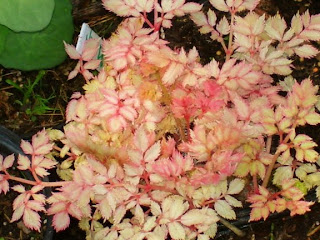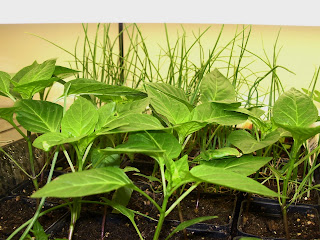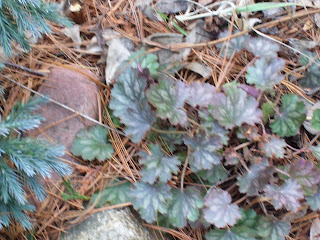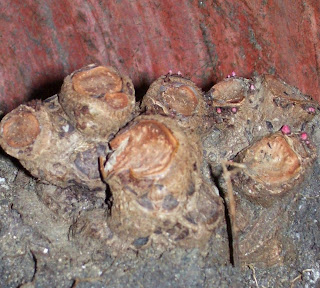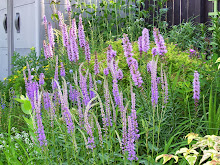
(The graph above showing degree days as of march 17, 2011, courtesy of http://www.soils.wisc.edu/uwex_agwx/thermal_models/tree.)
We are increasingly becoming global citizens in our outlook and the availability of information on gardening on the internet. Every so often I come across pictures of gardeners doing some exotic gardening task while I still have two feet of snow on the ground. My ex-husband, with whom, I am still chummy, confined that he saw an old mutual friend while out buying mulch to mulch the garden I left when I divorced him. "Would you believe I used 50 bags of mulch last year!"
I looked at him dumbly, "Huh?" I still have frozen ground, and plenty of snow, and had to chip the ice out of my co mingled plastics and glass, Wednesday.
This is the way of the world, I guess. He lives 180 miles to the south, surrounded by asphalt and concrete. Here in the Central Sands of Wisconsin, those Canadian Artic blasts just keep bringing it on! I wore my winter coat to school this morning. A fire burns in my fireplace. Someone searched this blog on "when in March to transplant berries..."
Transplant berries in in March?
I've been thinking of making the trek to the Community Library with the sole purpose of seeing how many more measureable snow days the village snow witch has forecast. (Yes, my village has a
snow witch. AND she, accurately forecasts such stuff as the exact frost date and number of snowfalls each year.)
I pay attention. I must just not be paying the right people, obviously.
Where I garden, no one is doing any berry transplanting in March. One strawberry grower keeps his covered with straw, until I think it is May 1! I'm a little more adventurous than that and I probably have a better selected cultivar as well. (I think Honeoye are just the BEST June-bearing strawberries, by the way.)
A couple years ago, I came across the idea of plant phenology or degree days. It's how to get "right and tight" with your zone. It is the idea that certain insect and plant things happen after there have been x-number of accumulated degree days. It usually centers around the idea of the hours where the temps reach 50 degrees.
This website (from the University of Massachusetts) gives a good explanation: http://www.umassgreeninfo.org/fact_sheets/ipmtools/gdd_phrenology.html
"Monitoring: Growing Degree Days and Plant Phenology
Timing
The growing use of less persistent, more environmentally benign pesticides, increased use of alternative management strategies and the rising costs of labor have all magnified the importance of accurate timing in pest management. Effective plant protection and efficient time management are dependent on our ability to predict pest activity. There are several ways to predict when pests are vulnerable to treatment or when monitoring for pest activity should begin. The calendar, calculation of growing degree days (GDD), and correlation of pest deveopment with plant phenology are the three most commonly used methods for insects and mites.
Calendar
The calendar method is based on following the historical record and past experience and is expressed as an approximate date. For example, gypsy moth egg hatch occurs in Massachusetts somewhere between late April and late May. As each spring in New England is unique and the season progresses differently in different areas, scheduling treatments by the calendar method alone can result in poor control, wasting both material and labor time.
Growing Degree Days (GDD)
Insects are cold-blooded animals whose activity and development is controlled by the temperature of the surrounding environment. It has long been recognized that growth could be measured indirectly by tracking temperature over time once the lower (baseline) and upper threshold temperatures for a particular insect were known. This would enable predictions of events in an insect's life cycle during the season by measuring growth in terms of temperature over time. While the concept of GDD has been around for many years, the baseline threshold temperatures are known for only a relatively few insect species. Currently, 50°F is used as a standard baseline for all insect and mite pests of woody plants. This standard was chosen because plant growth in the northeast is thought to start between 45° F and 55°F. Obviously, the farther an insect or mite's true baseline is from 50°, the less accurate these range numbers are. However, in most cases, the GDD method is proving to be much more accurate than the calendar method.
EXAMPLE:
average daily temperature - baseline temperature = growing degree days gained. (Negative numbers are ignored as growth does not go backwards.) If the high temperature for April 1 was 70°and the low was 60° then the average temperature for April 1 was 65° F.
70° + 60°
--------------------------------------------------------------------------------
2
= 65°
When a baseline temperature of 50° is used, the accumulation for April 1 is 15 growing degree days.
(GDD): 65 - 50 = 15 GDD.
As each day's GDD are added to the total, a growth unit calendar for the season is created. Gypsy moth egg hatch is known to occur between 90 and 100 GDD. By the calendar, this can be anywhere from late April to late May, a range of some 30 days. In contrast, if growing degree days are closely observed as they approach 90, egg hatch can be predicted within a few days.
The daily average temperature is readily available from weather stations or newspapers, or is easy to record using a high-low thermometer, thermograph, or a Biophenometer.
Approximate GDD Scale for Massachusetts
March, April, May, June July August, September October
--------------------------------------------------------------------------------
0 500 1000 1500 2000 2500 3000
Plant Phenology
Plant growth also responds to accumulating heat units to some degree. Bud swell, leaf emergence, flowering, fruiting, and other growth stages can be correlated to the growth stages of some insects and mites. Continuing with the example of gypsy moth egg hatch, this is said to occur about the time Amelanchier (shadbush) is in bloom. However, as day length and other environmental factors can affect specific events in a plants life cycle and different cultivars frequently have different bloom periods, these correlations are less precise than using GDD, but more accurate than using calendar dates. As landscapers and nursery workers can easily observe bloom and other plant events as they perform their normal routines, this is an attractive method for basing monitoring and management. Plant phenology and GDD information relative to Massachusetts' plants and insects has been researched and are incorporated into fact sheets and newsletters. Weekly GDD accumulations and current plant bloom are available through the Landscape Message. As with relying on a calendar approach, caution should be exercised when using GDD and phenology. Both are meant as an aid to monitoring, not as a substitute for visual confirmation. "
This website is based in Wisconsin.This one lets you fill in your location info and will shoot out the current information for organic pest management, planting, and whatnot.This last page by plugging in my location info and apple scab as the pest I wanted to work with, on the day I sprayed my dormant oil it showed I had already accumulated between 106 and 113 degree days. (I sprayed about 1 PM.) A lot of science here!































